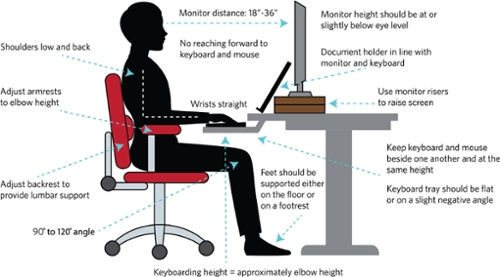
Over the past few weeks, businesses across the country have transitioned in-office employees to a work from home environment as they attempt to manage the threat of coronavirus or COVID-19.
While working from home might come with many things to love – extra time with your furry friends and a nonexistent commute – your make shift home office might not be doing your posture any favors. As the work from home environment becomes your new normal, you, and your back, might find yourself missing your ergonomic office chair.
Experts say that creating a designated work space is key to continuing a high-level of productivity and keeping work and life separate as you work from home. As you create your home office space, Sarah Ross, assistant professor in the Department of Physical Therapy in Samford University’s School of Health Professions, offers ergonomic solutions that will keep your neck, back and the rest of your body happy and healthy.
Chair
Ross suggests choosing a chair that supports your spinal curves. “Adjust the height of your chair so that your feet rest flat on the floor or on a footrest and your thighs are parallel to the floor. Adjust armrests so your arms gently rest on them with your shoulders relaxed,” says Ross.
Your chair should also offer good lumbar support. Our backs are slightly curved inward, meaning the backs of our chairs shouldn’t be directly vertical. Instead, they should support our lower backs by coming forward. Many office chairs come with built-in lumbar support but if your chair doesn’t have lumbar support built-in, Ross suggests strapping a rolled-up towel or something similar on your chair.
Desk
Under the desk, make sure there's clearance for your knees, thighs and feet. “If the desk is too low and can't be adjusted, place sturdy boards or blocks under the desk legs,” said Ross. “If the desk is too high and can't be adjusted, raise your chair and use a footrest to support your feet as needed. If a footrest is not available, try a small stool or a stack of books.”
Keyboard and Mouse
Your mouse should be placed within easy reach and on the same surface as your keyboard. Keep your mouse and keyboard as close together as possible, with the alphanumeric part of the keyboard centered on your desk. “Instead of putting the whole keyboard in the center of your desk, keep an eye on the “B” key. You want that to be directly in front of you and in the center of your desk,” says Ross.
While typing or using your mouse, Ross says to keep your wrists straight, your upper arms close to your body, and your hands at or slightly below the level of your elbows. If your desk has a hard edge, pad the edge or use a wrist rest to protect your wrist.
Monitor
Place your monitor directly in front of you, about an arm's length away. You want the point about two or three inches down from the top of the monitor casing to be at eye level. The monitor should be directly behind your keyboard. If you wear bifocals, Ross says you should lower the monitor an additional one to two inches for more comfortable viewing.
Posture
Remembering to keep good posture is key according to Ross. “Sitting with your seat back reclined too far is one of the biggest problems. You should be seated upright with your back at about a 100-degree angle to your legs.”
Even after creating the perfect ergonomic home office space, Ross says it is still important to take frequent breaks. She suggests taking a give minute break from your screen every half hour to hour. She also encourages the 20-20-20 rule. “Every 20 minutes, take 20 seconds to look away from your screen and at something 20 feet away from you.”
To view the most recent information about Samford University related to COVID-19, visit our COVID-19 webpage for ongoing updates.